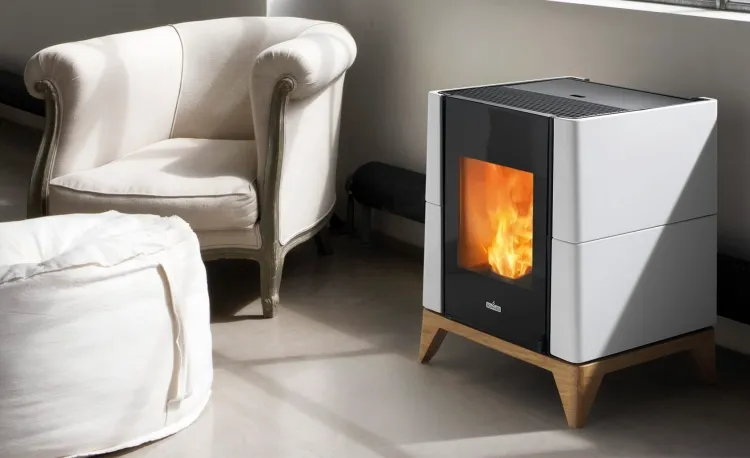The cost of heating a home can represent nearly 30% of a family’s annual expenses. Managing energy consumption is one of the main reasons a growing number of homeowners are looking for alternative methods to stay warm during the colder months. Some use pellet stoves as primary or secondary heat sources in winter. While these types of devices can be convenient and economical, it’s important to follow some key safety guidelines and precautions when considering installing one in your home. Are pellet stoves dangerous and what are the health risks? We take a look in the lines below.
Are pellet stoves dangerous?
Pellet stoves are very safe household solid fuel heaters as long as they are properly installed and maintained. Unlike wood burning stoves, they require a source of electricity to operate. This allows them to control fire more precisely. The most common problems associated with pellet stoves are fires caused by faulty wiring or an accumulation of flammable materials in their interior. Appliances should be regularly inspected by a qualified technician to ensure that they are operating safely.
Take care when near your pellet stove, especially near the front glass. Consider placing a heat shield, grill or barrier around it to prevent young children and pets from getting close and getting burned.
Can a pellet stove catch fire?
Pellet stove fires are rare, but they are a hazard that can occur occasionally with devastating consequences. The most common cause is improper disposal of ashes from the stove. More specifically, it is ashes that have not completely cooled, which are spread on or next to a combustible surface or object. They should be collected in an airtight metal container, on a noncombustible surface, until absolutely cold. 24 hours is reasonable. In addition, there are also special vacuum cleaners for cleaning pellet stoves, with metal bodies, flame-retardant filters and heat-resistant hoses.
Inadequate clearance of combustibles is the second most common cause of pellet stove fires. In the event of a malfunction, an abnormal fire may occur inside the device. In the most serious case, this fire can spread to the hopper which contains the pellets. Two things can cause this situation.
First, blockage of airflow to the burn pot may be the result of ash buildup underneath. Remove the burn pot regularly and check that the airflow is free. Sometimes air holes can get clogged – they need to be checked and cleaned regularly. The second situation is when poor quality or damp pellets are slow to ignite, causing a similar buildup. In this case, the pile of smoldering pellets may suddenly ignite and cause a small explosion in the stove.
Although pellet stoves burn much cleaner than other solid fuel stoves and most of the creosote that causes chimney fires is burned off, after a while it builds up in the vent pipe. A flue fire is very dangerous because pellet stove equipment is not designed to withstand high temperatures. The joints between the sections are destroyed and the fire could easily spread through the house. Regular inspection and cleaning is therefore the only way to guard against this risk.
Are pellet stoves dangerous: How to detect the presence of carbon monoxide in the room?
If you use a wood stove, pellet stove, hydronic heating system, boiler or fireplace, the appliances must be properly installed, vented and regularly maintained to avoid potentially dangerous situations. A chemical reaction that produces carbon monoxide (CO) can occur during storage of wood pellets.
In reality, pellet stoves are cleaner than wood stoves. The latter emit about 3.5 kg of fine dust per 1000 hours, while for pellet stoves this figure is only 0.68 kg. A pellet appliance is therefore more environmentally friendly than a wood stove, but it still emits more ultrafine dust than gas or electric heating. Ultrafine dust from pellet stoves poses a risk to vulnerable groups. Think of people with bronchitis, asthma and lung problems.
Other research has shown that the particles emitted from pellet stoves, although fewer in number than those emitted from log stoves, tend to be of the size of small fine particles. The latter are particularly harmful to health, as they penetrate the deepest parts of the lungs and can enter the bloodstream.
Install carbon monoxide (CO) detectors to warn you of potentially dangerous levels. Be sure to replace the batteries before each heating season. If you hear the CO alarm, move to fresh air immediately.
How do you know if the pellets are of good quality and safe for health?
Use only pellets recommended by the manufacturer to help your stove operate safely and efficiently. Bad quality can lead to increased maintenance and poor performance. Consumers should primarily consider the following characteristics of pellets:
- Size: most pellets are 6 or 8 mm in diameter and about 3 to 4 times that diameter in length.
- Moisture content: it must be between 8 and 10%.
- Ash content: Good quality wood pellets have very low ash content, less than 0.7%.
Look for pellets made from 100% natural hardwood. They are produced without bark, filler and binder. They are therefore a clean source of fuel that burns steadily, with a uniform temperature and speed. High quality pellets guarantee the proper functioning of your stove.
Read also: What’s the Best Way to Store Wood Pellets? – Indoor and Outdoor Solutions!





